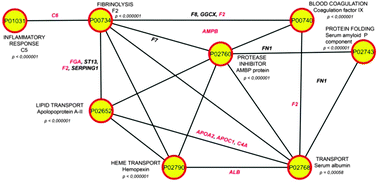We carried out a systems-level study of the mechanisms underlying organ-specific metastases of breast cancer. We followed a network-based approach using microarray expression data from human breast cancer metastases to select organ-specific proteins that exert a range of functions allowing cell survival and growth in the microenvironment of distant organs. MinerProt, a home-made software application, was used to group organ-specific signatures of brain (1191 genes), bone (1623 genes), liver (977 genes) and lung (254 genes) metastases by function and select the most differentially expressed gene in each function. As a result, we obtained 19 functional representative proteins in brain, 23 in bone, 15 in liver and 9 in lung, with which we constructed four organ-specific protein–protein interaction networks. The network taxonomy included seven proteins that interacted in brain metastasis, which were mainly associated with signal transduction. Proteins related to immune response functions were bone specific, while those involved in proteolysis, signal transduction and hepatic glucose metabolism were found in liver metastasis. No experimental protein–protein interaction was found in lung metastasis; thus, computationally determined interactions were included in this network. Moreover, three of these selected genes (CXCL12, DSC2 and TFDP2) were associated with progression to specific organs when tested in an independent dataset. In conclusion, we present a network-based approach to filter information by selecting key protein functions as metastatic markers or therapeutic targets.

You have access to this article
 Please wait while we load your content...
Something went wrong. Try again?
Please wait while we load your content...
Something went wrong. Try again?


 Please wait while we load your content...
Please wait while we load your content...